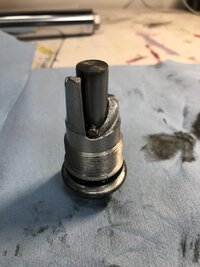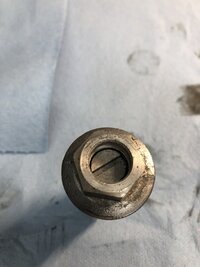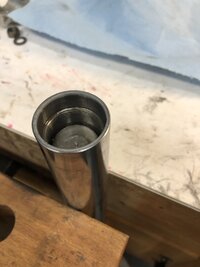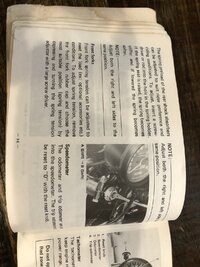Taking the front fork apart for cleaning and checking - found that it have a top cap bolt that appear to be adjustable. Is this original for any XS ?? This came on my 1978 XS650E. It’s as expected otherwise 35mm etc.
-
Enjoy XS650.com? Consider making a donation to help support the site.
XS650.com receives a small share of sales from some links on this page, but direct donations have a much greater impact on keeping this site going.
You are using an out of date browser. It may not display this or other websites correctly.
You should upgrade or use an alternative browser.
You should upgrade or use an alternative browser.
Front fork - adjustable cap bolt
- Thread starter Niels B
- Start date
Yes, the adjustable top caps came on all the '78 and newer models. Nice feature, and you may need it if your springs are the originals. They tend to be a bit soft after all these years. Each step adds 10mm of preload to the springs .....

The pins can seize up in the caps if you get water in there so make sure to use the rubber protection caps Yamaha provided .....

In an effort to stop this from happening, I pack some grease up into the pin on the bottom side, working the pin up and down to get it up in there .....

The pin has an o-ring on it to seal it into the cap so to treat that, I coat the pin bore on top with red rubber grease, again working it in and out to distribute it .....

The pins can seize up in the caps if you get water in there so make sure to use the rubber protection caps Yamaha provided .....
In an effort to stop this from happening, I pack some grease up into the pin on the bottom side, working the pin up and down to get it up in there .....
The pin has an o-ring on it to seal it into the cap so to treat that, I coat the pin bore on top with red rubber grease, again working it in and out to distribute it .....
Thanks for the update. My manual did not reveal this in any of the different view of the various forks 
I've found that even with the adjusters set at the max (adding 20mm of preload), the forks are often still too soft, so I added some small preload spacers. My goal was to get a little more preload than the caps provided (20mm) so I made the spacers 1" long (about 25mm). However, I failed to take into account the extra washer I added, which tacked another few MM onto the preload. This gave me 27 or 28mm of preload, almost another full step on the adjuster, and that proved to be too much. The forks were too stiff .....


So, I pulled the spacers and shortened them a bit, down to 13/16". Now, combined with the added washer, this gave about 22 to 24mm of added preload, and this has proved to be ideal.
So, I pulled the spacers and shortened them a bit, down to 13/16". Now, combined with the added washer, this gave about 22 to 24mm of added preload, and this has proved to be ideal.
And still no coil bind?I've found that even with the adjusters set at the max (adding 20mm of preload), the forks are often still too soft, so I added some small preload spacers. My goal was to get a little more preload than the caps provided (20mm) so I made the spacers 1" long (about 25mm). However, I failed to take into account the extra washer I added, which tacked another few MM onto the preload. This gave me 27 or 28mm of preload, almost another full step on the adjuster, and that proved to be too much. The forks were too stiff .....
View attachment 218333
View attachment 218334
So, I pulled the spacers and shortened them a bit, down to 13/16". Now, combined with the added washer, this gave about 22 to 24mm of added preload, and this has proved to be ideal.
With that much added preload being required, I'd be inclined to get stiffer springs ( a higher spring rate)
looks like you did your homework LOL
Yes, I figured if I could save the cost of new springs ($50 to $75), it was worth a little time, effort, and research on my part. Plus, I just like to tinker with bike stuff, lol. So, the firmed up springs combined with the Minton Mods (something else I researched and "fixed"), and slightly more than the stock amount of oil (6.5 to 7 ounces instead of the just under 6 stock amount) makes a nice improvement on these forks. Short of emulators and custom straight wound springs, which will run you several hundred dollars, this is the best you can do. It's basically free and I think most will find the improvements adequate.
Are you using regular oil as recommended in the manual or a specific oil for forks ? By the way went digging in the starch I got from Gordon NC as I recalled a owners manual for the E and here is the only ref I can find in regards to the top cap nut tensioner
Attachments
Got these on all my 650 Specials, can't stand the things TBH, I just turn up to max pre-load and forget them.
Maybe another 20mm of pre-load would help - I weigh about 240 lbs these days.
I must say that it's nice to see someone making the effort to make Yamaha's forks work at their optimum - rather than bolt on some high tech items from some modern rocket ship.
Maybe another 20mm of pre-load would help - I weigh about 240 lbs these days.
I must say that it's nice to see someone making the effort to make Yamaha's forks work at their optimum - rather than bolt on some high tech items from some modern rocket ship.
I think many bikes from the '70s called for regular oil simply because real fork oil wasn't that common or available back then. Today it's easy to get so that is what I use, but nothing special, just the regular, plain jane fork oil. I also stick with the recommended 10wt. Thicker oil would just slow down the fork action, which was an issue already with these forks. That's what the Minton Mods addresses. By drilling the holes in the damper rods slightly larger, you reduce the damping a little and let the oil flow easier. This makes the forks more responsive, especially over the little bumps.
Frame's done.Are you using regular oil as recommended in the manual or a specific oil for forks ? By the way went digging in the starch I got from Gordon NC as I recalled a owners manual for the E and here is the only ref I can find in regards to the top cap nut tensioner
Just curious, by adding more preload to the spring will that also 'extend' the forks slightly while the bike is on the kickstand? For example, I have stock length fork tubes with the fork adjusters set to minimum preload. There is about 4.5 inches between the top of the fork seal cap and the bottom of the triple tree. If I go to the max preload will it also add an additional 20mm of (stiffer) travel ? (or did your 22-24 mm of added preload 'lengthen' your forks about an inch?)I've found that even with the adjusters set at the max (adding 20mm of preload), the forks are often still too soft, so I added some small preload spacers. My goal was to get a little more preload than the caps provided (20mm) so I made the spacers 1" long (about 25mm). However, I failed to take into account the extra washer I added, which tacked another few MM onto the preload. This gave me 27 or 28mm of preload, almost another full step on the adjuster, and that proved to be too much. The forks were too stiff .....
View attachment 218333
View attachment 218334
So, I pulled the spacers and shortened them a bit, down to 13/16". Now, combined with the added washer, this gave about 22 to 24mm of added preload, and this has proved to be ideal.
Honestly, that's not something I ever checked, but it does make sense that the forks wouldn't compress as much under the weight of the bike if the preload caps were at max or if preload spacers were added. It may not exactly equal the amount of preload added though.
Is this increased amount of fork oil the same qty for my ‘76?Yes, I figured if I could save the cost of new springs ($50 to $75), it was worth a little time, effort, and research on my part. Plus, I just like to tinker with bike stuff, lol. So, the firmed up springs combined with the Minton Mods (something else I researched and "fixed"), and slightly more than the stock amount of oil (6.5 to 7 ounces instead of the just under 6 stock amount) makes a nice improvement on these forks. Short of emulators and custom straight wound springs, which will run you several hundred dollars, this is the best you can do. It's basically free and I think most will find the improvements adequate.
I guess I’ll have to do a little experiment and find out! I’ll take measurements and let you know.Honestly, that's not something I ever checked, but it does make sense that the forks wouldn't compress as much under the weight of the bike if the preload caps were at max or if preload spacers were added. It may not exactly equal the amount of preload added though.
I don't know if this oil amount would apply to the 34mm forks on a '76 model. You would have to do some experimenting. Another way to set fork oil amount is by measuring the level, springs removed, forks fully compressed. An often mentioned level is 6" from the tops of the tubes. This works on the 35mm forks, giving you about 6 1/2 ounces in them. You'd have to experiment on the 34mm forks. I'd put whatever the recommended amount is in, then take that measurement. You'll probably find the level lower than 6". Add more oil to each leg, maybe an ounce, measure, then suck off the excess to bring the level to 6". They sell fork oil leveling tools but I have a homemade one. It's simple to make out of brass tubing .....


Adding preload will decrease your laden sag. I think that’s what you’re asking about. So, longer with you sitting on it.Just curious, by adding more preload to the spring will that also 'extend' the forks slightly while the bike is on the kickstand? For example, I have stock length fork tubes with the fork adjusters set to minimum preload. There is about 4.5 inches between the top of the fork seal cap and the bottom of the triple tree. If I go to the max preload will it also add an additional 20mm of (stiffer) travel ? (or did your 22-24 mm of added preload 'lengthen' your forks about an inch?)
Even for those who want to stay with stock springs and damping, there is some really good technical info om websites like RaceTech and Ohlins. They also sell books about suspension tuning and setup
Max Midnight
XS650 Addict
Look up 'Static sag'.Just curious, by adding more preload to the spring will that also 'extend' the forks slightly while the bike is on the kickstand? For example, I have stock length fork tubes with the fork adjusters set to minimum preload. There is about 4.5 inches between the top of the fork seal cap and the bottom of the triple tree. If I go to the max preload will it also add an additional 20mm of (stiffer) travel ? (or did your 22-24 mm of added preload 'lengthen' your forks about an inch?)
Increasing the static sag will reduce how much the weight of the bike will compress the springs and unloaded the bike may well sit higher.
Similar threads
- Replies
- 2
- Views
- 672




